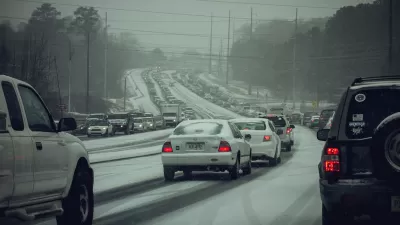Following in the footsteps of the "snowmageddon" events experienced by Atlanta in January 2014, Portland, Oregon had a surprising amount of difficulty with a small amount of snow this week.

Gillian Flaccus of the Associated Press shares news of the effects of a rare snowstorm in Portland, Oregon on Wednesday, December 14, 2016. The local story made the national news for its depiction of a crippled commute, abandoned cars, and closed schools.
Picking up the news for Bike Portland, Jonathan Maus contributed a critical perspective about why the day went so wrong.
Here’s the inconvenient truth: Our over-reliance on single-occupancy motor vehicle use has real consequences. It leads to lots of injuries and deaths, it poisons our lungs, and it makes our transportation system extremely fragile and inefficient.
To further that point, Maus shared an infographic illustrating the "Hierarchy of Mobility Resiliency." At the top "Feet." At the bottom "Cars." Maus's argument comes as a response to an article by The Oregonian, neglecting Maus's point but laying the blame on these five causes:
- Portland doesn't salt roads.
- Motorists don't carry chains.
- Drivers aren't experienced in snowy conditions.
- Portland doesn't have many snow plows.
- Transit doesn't reach to many parts of the city.
Also writing for The Oregonian, Lizzy Acker found enough good humor to scour social media for snarky takes on the whole bad snow day.
While Portland's considering how this snow storm had such a crippling effect on the city, it might want to consider the example of Atlanta, which was shut down for several days in January 2014 by just a few inches of snow. The event, dubbed "snowmaggedon," was also described by many commentators as a result of auto dependency.
FULL STORY: Winter Storm Snarls Portland Traffic, Stranding Thousands

Alabama: Trump Terminates Settlements for Black Communities Harmed By Raw Sewage
Trump deemed the landmark civil rights agreement “illegal DEI and environmental justice policy.”

Planetizen Federal Action Tracker
A weekly monitor of how Trump’s orders and actions are impacting planners and planning in America.

The 120 Year Old Tiny Home Villages That Sheltered San Francisco’s Earthquake Refugees
More than a century ago, San Francisco mobilized to house thousands of residents displaced by the 1906 earthquake. Could their strategy offer a model for the present?

Ken Jennings Launches Transit Web Series
The Jeopardy champ wants you to ride public transit.

BLM To Rescind Public Lands Rule
The change will downgrade conservation, once again putting federal land at risk for mining and other extractive uses.

Indy Neighborhood Group Builds Temporary Multi-Use Path
Community members, aided in part by funding from the city, repurposed a vehicle lane to create a protected bike and pedestrian path for the summer season.
Urban Design for Planners 1: Software Tools
This six-course series explores essential urban design concepts using open source software and equips planners with the tools they need to participate fully in the urban design process.
Planning for Universal Design
Learn the tools for implementing Universal Design in planning regulations.
Clanton & Associates, Inc.
Jessamine County Fiscal Court
Institute for Housing and Urban Development Studies (IHS)
City of Grandview
Harvard GSD Executive Education
Toledo-Lucas County Plan Commissions
Salt Lake City
NYU Wagner Graduate School of Public Service



























